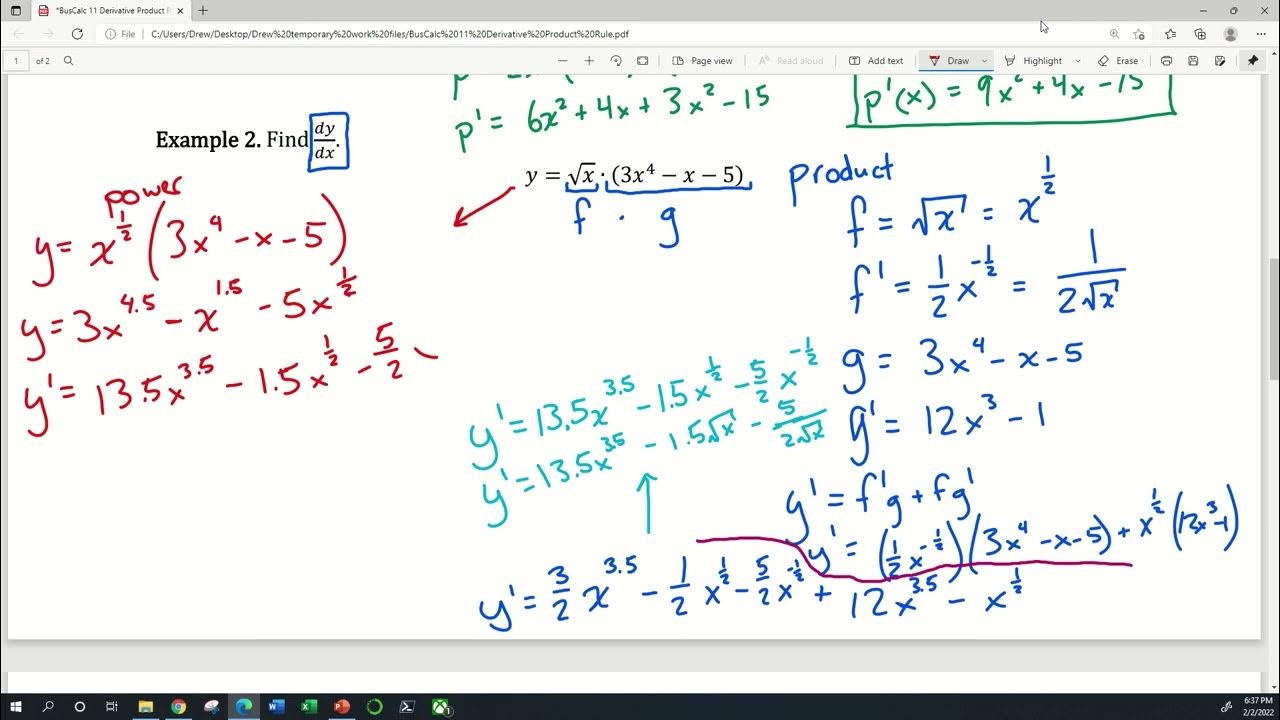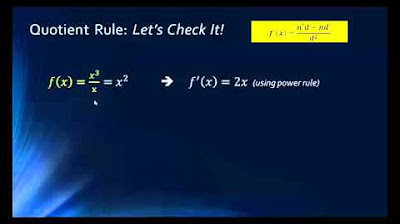Product rule proof | Taking derivatives | Differential Calculus | Khan Academy
TLDRThis video script offers a detailed walkthrough of the product rule's proof, starting from the fundamental definition of a derivative. It initially presents the challenge of finding the derivative of a product of two functions, F(x) and G(x), using the derivative's basic definition. The script then introduces an ingenious algebraic manipulation by adding and subtracting the same term, which allows for the expression's simplification. Through factoring and applying limit properties, it meticulously derives the product rule, illustrating that the derivative of the product of two functions equals the first function times the derivative of the second plus the second function times the derivative of the first. This explanation not only clarifies the product rule's logic but also underscores the beauty of mathematical reasoning.
Takeaways
- 📚 The video provides a detailed proof of the product rule used in calculus.
- 🔢 The proof begins with the basic definition of a derivative, highlighting its fundamental importance.
- 🔄 The derivative of a product of two functions, F(x) and G(x), is the main focus, applying the standard derivative definition.
- 🤔 The proof introduces a 'trick' by adding and subtracting the same term to facilitate algebraic manipulation.
- 🧠 This 'trick' allows the expression to be split into parts that are more manageable for limit evaluation.
- 📉 By factoring out common terms, the expression is reorganized to reveal the product rule structure.
- ✔️ The proof uses limit properties to break down the expression into simpler parts, each of which approaches a limit.
- 🌟 The final step involves evaluating the limits, leading to the classic product rule expression.
- ✨ The product rule is summarized as the first function times the derivative of the second plus the second function times the derivative of the first.
- 🎓 The video encourages viewers to engage with the material by pausing and reflecting on the steps of the proof.
Q & A
What is the main topic of the video?
-The main topic of the video is to provide a satisfying proof of the product rule in calculus.
How is the derivative of a function defined in the video?
-The derivative of a function F of X is defined as the limit as H approaches zero of (F of (X plus H) minus F of X) divided by H.
What is the visual interpretation of the derivative mentioned in the video?
-The visual interpretation of the derivative mentioned in the video is the slope of the tangent line to the function at a given point.
What is the goal of the video after defining the derivative?
-The goal of the video after defining the derivative is to find the derivative with respect to X of the product of two functions, F of X and G of X.
How does the video approach the algebraic manipulation of the expression for the product rule?
-The video suggests adding and subtracting the same term (F of X plus H) to the expression to make it easier for algebraic manipulation.
What is the algebraic trick shown in the video to simplify the product rule expression?
-The algebraic trick is to factor out F of (X plus H) and G of X from the expression to simplify it into a form that resembles the classic product rule.
What are the two main parts the video breaks the expression into after the algebraic manipulation?
-The two main parts are (F of (X plus H) times (G of (X plus H) minus G of X)) divided by H and (G of X times (F of (X plus H) minus F of X)) divided by H.
How does the video use limit properties to simplify the expression further?
-The video uses the properties that the limit of a sum is the sum of the limits and the limit of a product is the product of the limits to simplify the expression.
What is the final simplified form of the product rule derived in the video?
-The final simplified form of the product rule is F of X times the derivative of G with respect to X plus G of X times the derivative of F with respect to X.
What is the significance of the proof provided in the video?
-The proof provided in the video is significant as it offers a deeper understanding of the product rule and demonstrates an alternative method to derive it beyond the standard approach.
How does the video encourage viewers to engage with the material?
-The video encourages viewers to pause and try to solve the problem on their own before continuing to watch, fostering active engagement with the material.
Outlines
📚 Introduction to the Product Rule
The video begins with an aim to provide a clear proof of the product rule in calculus. It starts by defining the derivative of a function F(x) as the limit of the difference quotient as h approaches zero. The narrator plans to extend this concept to the product of two functions, F(x) and G(x), by using the derivative's definition. Through a detailed explanation, the narrative sets up a complex rational expression that needs manipulation to arrive at the product rule, introducing an intentional 'awkward space' in the equation to hint at the forthcoming algebraic trick of adding and subtracting the same term to facilitate the proof.
🔍 Deriving the Product Rule
In the second paragraph, the script delves deeper into the algebraic manipulation needed to prove the product rule. It breaks down the expression by factoring out common terms, F(x + h) and G(x), leading to the demonstration of the limit properties that separate the equation into manageable parts. The narrative builds suspense and guides the viewer through the step-by-step process of applying limit properties, ultimately revealing the product rule's proof. The segment concludes by expressing the product rule in a simplified form, emphasizing the interplay of the functions and their derivatives, thus proving the rule through a structured and engaging explanation.
Mindmap
Keywords
💡Derivative
💡Product Rule
💡Limit
💡Tangent Line
💡Algebraic Manipulation
💡Factoring
💡Limits Properties
💡Slope
💡Rational Expression
💡Proof
💡Function
Highlights
The video aims to provide a satisfying proof of the product rule.
The definition of a derivative is introduced as the limit of the difference quotient.
The concept of the derivative is extended to the product of two functions, F(X) and G(X).
A new approach is introduced to apply the definition of a derivative to the product of two functions.
The expression for the derivative of the product is simplified through algebraic manipulation.
The video demonstrates a method to evaluate the limit as H approaches zero in the context of the product rule.
The process of factoring out F(X+H) and G(X+H) from the expression is explained.
The use of limit properties to break down the expression into simpler components is highlighted.
The video shows how to express the derivative of the product of two functions using limits of sums and products.
The classic product rule formula is derived from the algebraic manipulation of the expression.
The proof involves the derivative of F(X) and G(X) being expressed as F'(X) and G'(X).
The final result of the derivative of the product of two functions is presented in both expanded and condensed forms.
The video provides a step-by-step explanation of the product rule, making it accessible for learning.
The proof showcases the power of algebraic manipulation and limit properties in calculus.
The video serves as an educational resource for those looking to understand the product rule in depth.
The explanation emphasizes the importance of understanding the underlying principles of calculus concepts.
The video's approach to the product rule proof is presented as a satisfying and engaging learning experience.
Transcripts
Browse More Related Video

Taking the derivative of two binomials using product and chain rule

Product Rule For Derivatives

BusCalc 11 Derivative Product Rule

Product Rule for Derivatives

Math 1325 Lecture 9 5 - Product & Quotient Rule

Finding derivative with fundamental theorem of calculus: chain rule | AP®︎ Calculus | Khan Academy
5.0 / 5 (0 votes)
Thanks for rating: